Discover 13 animals in Jasper National Park from our hikes—photos capture every wild encounter!
Ready to meet the locals of Jasper National Park? We’re not just talking about the rangers but the real stars: the animals!
On our hikes, we bumped into everyone – the towering elks, the stealthy bears, and even those rock-climbing goats and sheep.
Our adventure through Jasper was like flipping through a wildlife album. Each trail brought us face to face with creatures right out of a nature documentary.
We saw majestic caribou moving like shadows through the forest, heard the call of the great horned owls, and caught glimpses of marmots and pikas playing hide and seek.
Join us through our photo journey, and who knows, you might just be inspired to lace up your boots and meet these critters in their epic mountain home. Get ready for some wild encounters!
Caribou
In Jasper National Park and you might just catch a glimpse of the majestic caribou – a member of the deer family that is larger than a deer but smaller than an elk. These remarkable animals have the biggest antlers and hooves in the deer family, allowing them to travel in deep snow, dig for food, and even paddle while swimming.
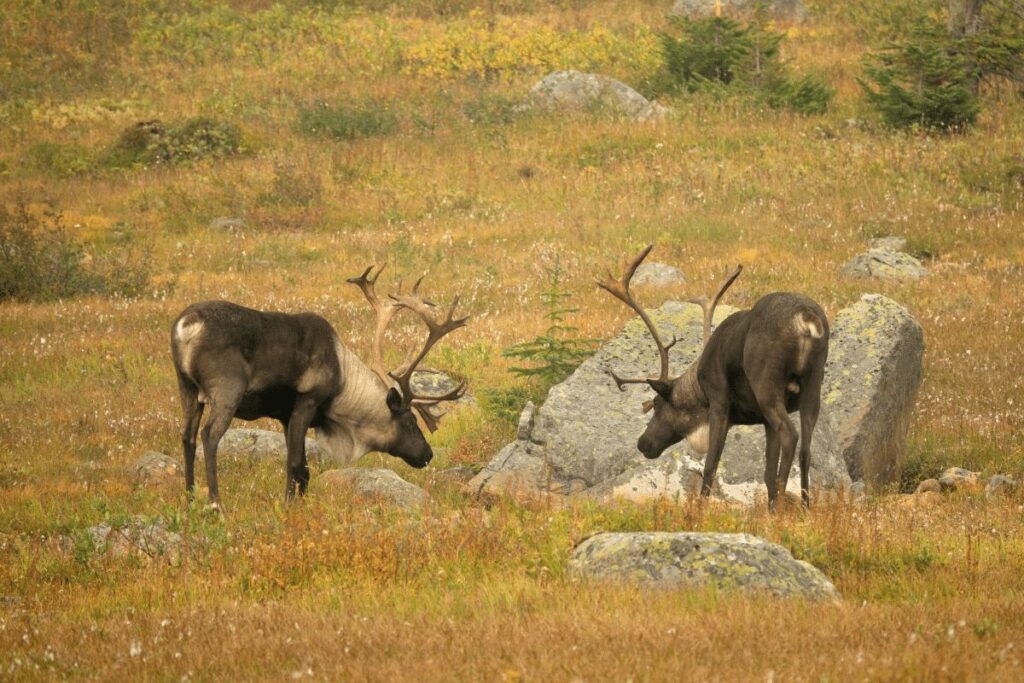
During the long, cold winters in the mountains, caribou survive by digging through the snow to eat lichens. If you’re lucky enough to spot them in June, you might see female caribou isolating themselves in remote areas to give birth and protect their young calves from predators like wolves, grizzly bears, and cougars.
But be warned, these caribou are part of a subgroup of woodland caribou herds called southern mountain caribou, which are endangered and in some cases, gone forever. Jasper National Park is home to four caribou populations, including À la Pêche, Brazeau, Maligne, and Tonquin.
You can find caribou in stable numbers in the Tonquin Valley and the Brazeau mountain ranges near the Icefields Parkway, and in larger numbers on either side of Jasper National Park’s northern boundary. So pack your bags, put on your hiking boots, and get ready for an unforgettable adventure in search of these magnificent creatures.
Elk or Wapiti
While hiking in Jasper National Park, we had the most thrilling encounter with a majestic elk. Known also as wapiti or red deer, these stunning animals are the second-largest species of deer in North America. With their impressive antlers and large stature, it’s no wonder they’re a popular sight for visitors to the park.
As we hiked through the park’s stunning wilderness, we caught sight of a magnificent bull elk standing in a clearing. Its antlers were massive and its powerful body exuded strength and grace. We watched in awe as the elk gracefully moved through the clearing, pausing occasionally to graze on nearby vegetation.
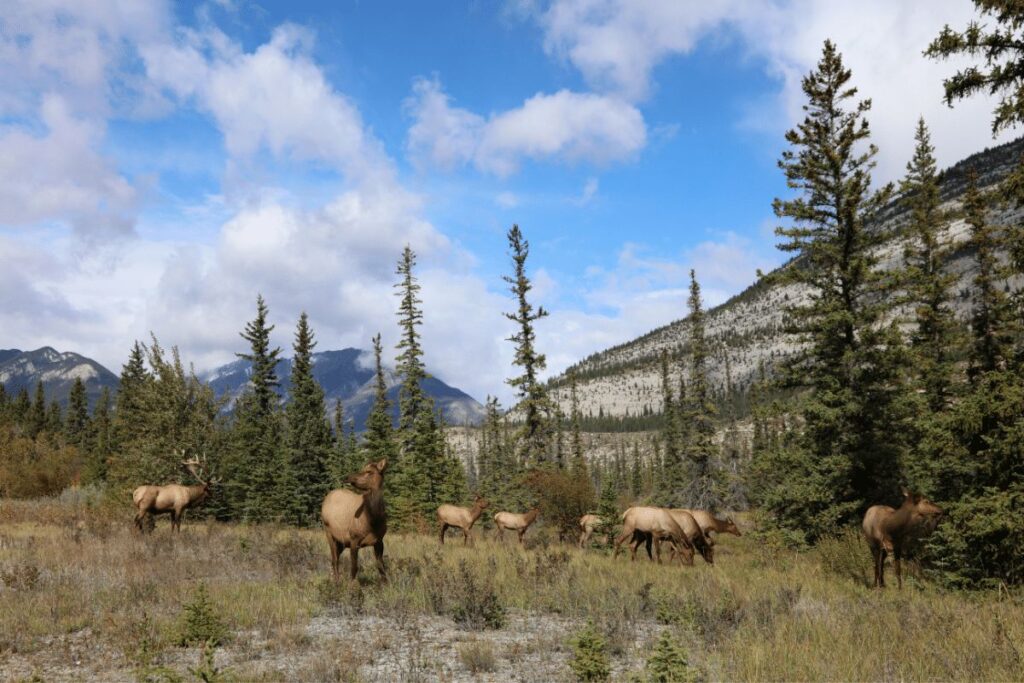
Elk are known for their unique vocalizations, which include bugling calls and grunts. We were lucky enough to hear the bull elk’s bugle, which is a loud, high-pitched call that is often heard during mating season. It was an incredible experience, and we felt privileged to witness such a breathtaking display of nature’s beauty.
Encounters like this remind us of the importance of preserving and protecting our natural world. We felt grateful for the opportunity to witness these incredible creatures in their natural habitat. If you’re planning a trip to Jasper National Park, keep an eye out for these stunning elk – you never know when you might have your own thrilling encounter with these magnificent animals.
Moose
Our hike in Jasper National Park turned into an unforgettable adventure when we stumbled upon a magnificent moose grazing near a clear, shimmering lake. Spotting a moose is always special, as these shy creatures are seen less frequently than other species such as elk, with a population of only about 150 in the park. We couldn’t believe our luck!
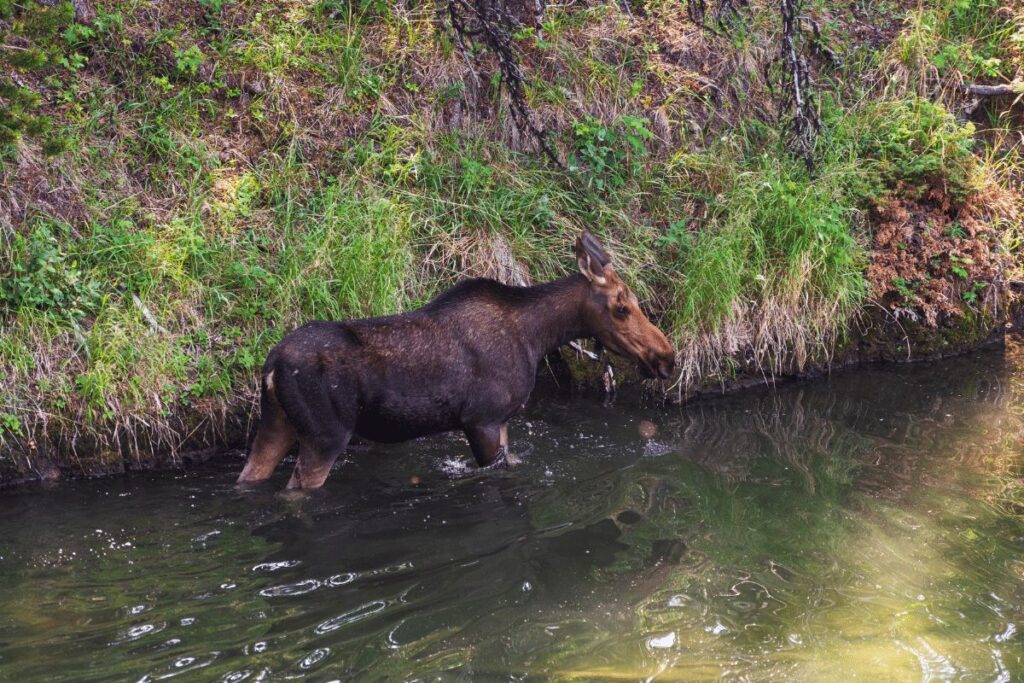
As we approached the moose, we were struck by its imposing presence – standing at almost 7 feet tall, it was an incredible sight to behold. Moose are known for their distinctive features, such as their long, gangly legs and broad, flat antlers, which male moose shed and regrow each year. It was amazing to see such a magnificent animal up close and personal.
In the summer, moose love to hang out near bodies of water, adding aquatic plant life to their foliage diet. We had heard that Maligne Lake, Medicine Lake, and Annette Lake were great locations to spot these beautiful creatures, and we were not disappointed. Watching the moose graze near the tranquil waters of the lake was a truly magical experience.
As we stood there in awe, we couldn’t help but feel a sense of gratitude for the opportunity to witness such a rare and special moment in the wilderness. It’s moments like these that remind us of the importance of preserving and protecting our natural world for future generations to come. If you’re planning a trip to Jasper National Park, keep an eye out for these incredible moose – you never know when you might have your own exciting encounter with these majestic creatures.
Mountain Goat
In Jasper we had the incredible opportunity to witness a family of mountain goats in their natural habitat. These magnificent animals are known for their distinctive white coats and impressive curved horns, and they are a true symbol of the rugged beauty of the Rocky Mountains.
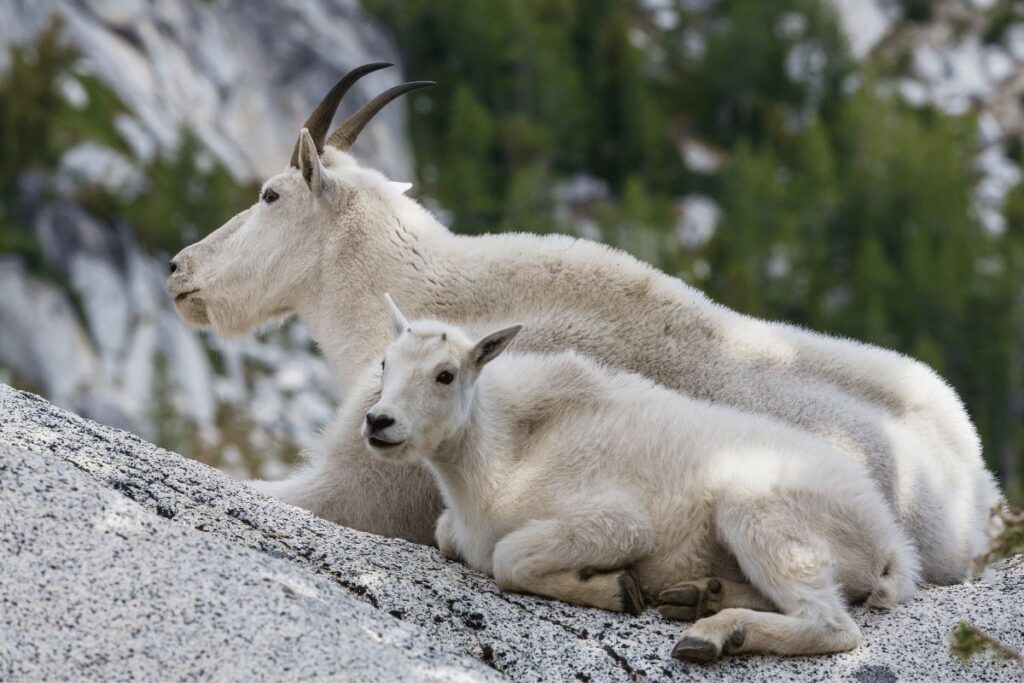
Mountain goats are not an uncommon sight in Jasper National Park, with populations scattered throughout the park’s stunning wilderness. However, they can be elusive creatures, so it was an absolute thrill to see them up close and personal.
We spotted the mountain goats as we were hiking along the Parker Ridge Trail, which is known for its incredible views of the surrounding mountains and glaciers. As we rounded a bend in the trail, we were greeted by a family of mountain goats grazing peacefully in a nearby meadow. They seemed completely unfazed by our presence, and we were able to observe them for several minutes as they went about their business.
Mountain goats are incredibly agile creatures, with specially adapted hooves that allow them to climb steep cliffs and rocky terrain with ease. It was truly amazing to watch them move with such grace and confidence in their natural environment.
Jasper National Park is home to several populations of mountain goats, with some of the best places to spot them including the Parker Ridge Trail, as well as the nearby Wilcox Pass and Icefields Parkway areas. If you’re planning a trip to Jasper, be sure to keep an eye out for these magnificent creatures – they are a sight you won’t soon forget.
Bighorn Sheep
We were lucky enough to happen upon three encounters with bighorn sheep during our hiking trip in Jasper National Park. About 3000 of these majestic creatures call the park home and can usually be found grazing on low grassy slopes or alpine meadows. Their coats are sandy-coloured, with a white rump, while rams have impressively curved horns and ewes shorter, spiky ones. As is typical for this species, they usually migrate to ensure they’re safely close to a rocky ledge, forming mixed herds of males and females during the winter months and separating into separate genders during the summertime.
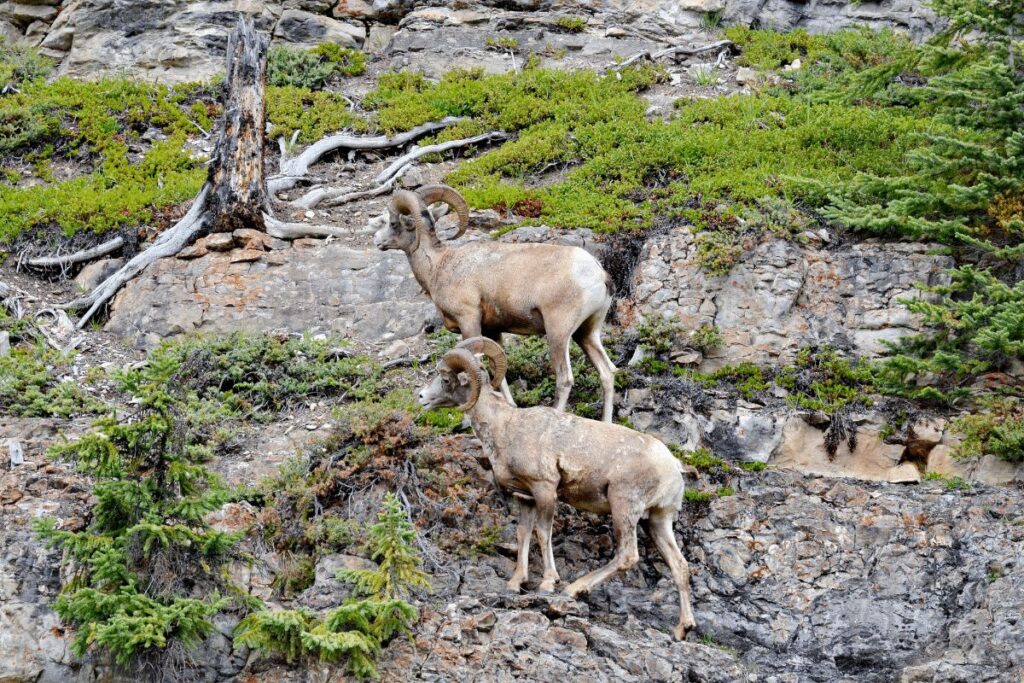
During the fall mating season, bighorn sheep rams compete for dominance by crashing their horns against each other until the weaker animal surrenders. We saw these impressive creatures on our drive along Highway 16 east of Jasper, along the Icefields Parkway near Tangle Falls, and while driving from Highway 16 to Maligne Lake. Bighorn sheep can be seen on Highway 16.
If you find yourself in Jasper during wintertime, it’s possible to witness a herd of bighorns grazing near Highway 16. Old Fort Point lookout and Wilcox Pass hike also offer great opportunities for watching these animals in their natural environment, not to mention Miette Hot Springs – visitors often spot bighorn sheep wandering around its parking lot.
Grizzly Bears
During our trip to Jasper National Park, we were fortunate enough to have a thrilling sighting of a grizzly bear in its natural habitat. These magnificent animals are a crucial part of the ecosystem, playing a significant role in shaping the landscape and maintaining the delicate balance of nature.
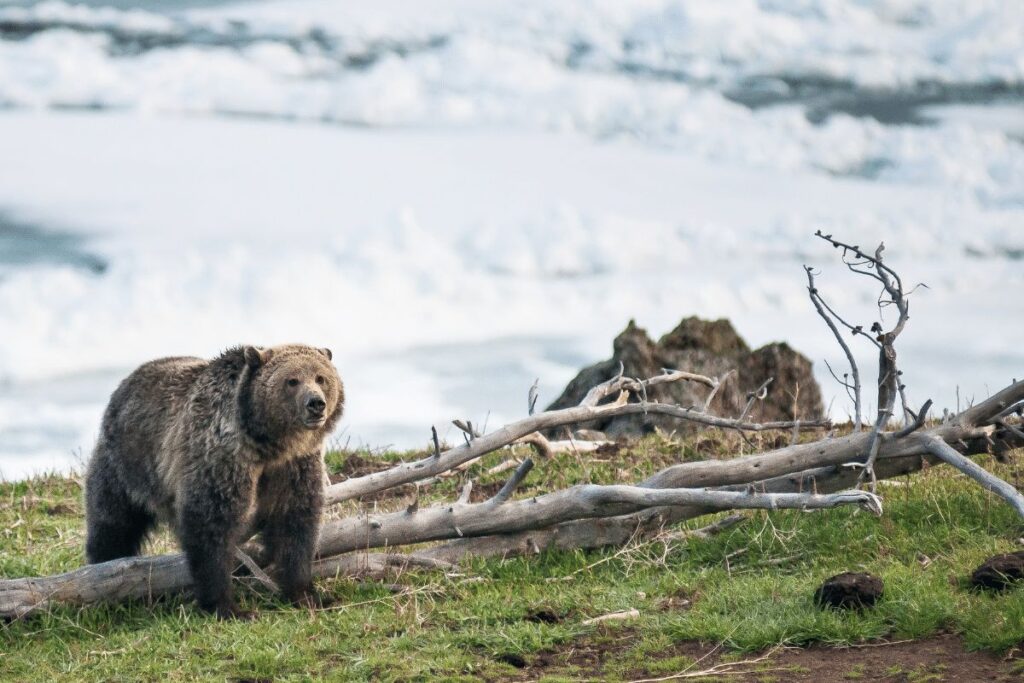
Grizzly bears are found in several areas of the park, but they are most frequently sighted in the eastern and northern parts. The park is home to approximately 65 grizzly bears, which is an impressive number given the large size of the park.
Grizzly bears are omnivorous and feed on a wide variety of foods such as berries, roots, insects, and small mammals. They are known for their exceptional sense of smell and can detect food from several kilometers away. In the fall, they consume up to 20,000 calories a day to prepare for hibernation.
As majestic as they are, grizzly bears are considered a threatened species, and Jasper National Park is a vital refuge for them. Parks Canada has implemented several measures to ensure the protection and conservation of grizzly bears in the park, such as bear-proof food containers, speed limits on roads, and closures of trails during sensitive periods.
Our grizzly bear sighting was a humbling and awe-inspiring experience that left us with a newfound appreciation for the beauty and fragility of nature. It is essential to remember that we are visitors in the grizzly bear’s territory and must respect their space and behavior to ensure their continued survival.
If you’re planning a visit to Jasper National Park, be sure to familiarize yourself with the park’s guidelines and regulations for grizzly bear encounters. Some of the best places to see grizzly bears in Jasper National Park include the Yellowhead Highway, Maligne Lake Road, and the Marmot Basin ski area. However, it is important to note that grizzly bear sightings are rare and unpredictable, so it is essential to always exercise caution and respect the bears’ territory.
Wolves
During our visit to Jasper National Park, we were lucky to witness a wolf pack in the wild. Wolves are a critical component of Jasper’s ecosystem, and sightings are becoming increasingly rare due to habitat loss and human encroachment. The park has taken measures to protect wolf populations, including implementing hunting restrictions and creating protected areas.
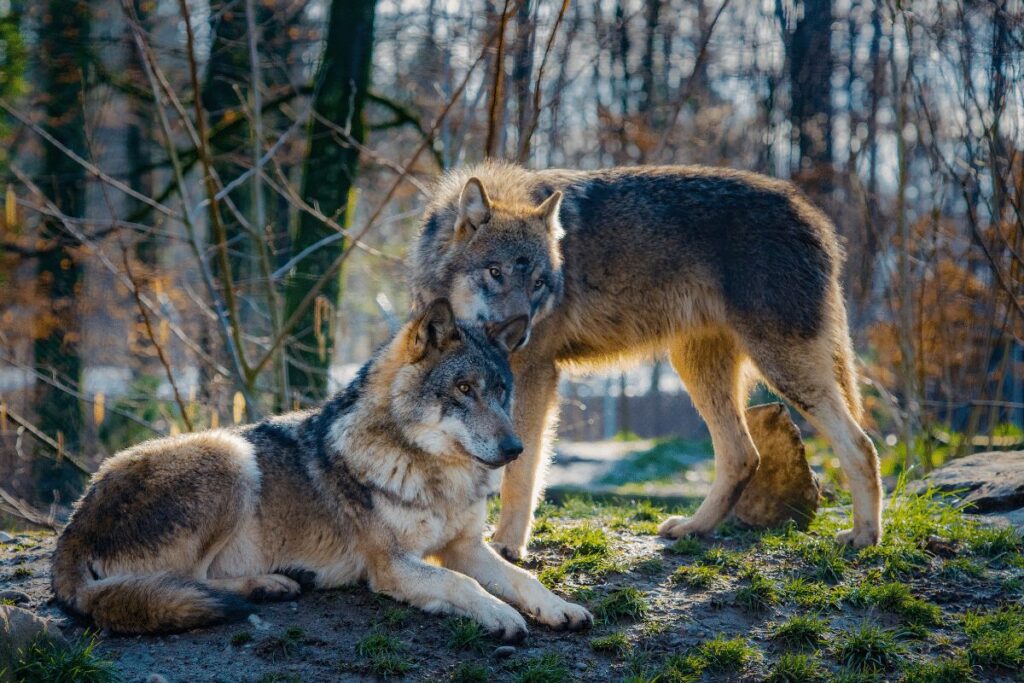
The wolves in Jasper National Park are typically grey wolves, also known as timber wolves. They have a grey or black coat, which provides excellent camouflage in the forested areas of the park. Wolves are social animals and live in packs of up to 10 individuals, with a dominant alpha pair leading the group. They have a complex social hierarchy and use a variety of vocalizations and body language to communicate.
During our wolf sighting, we watched in awe as the pack moved through the forest, with the alpha pair leading the way. It was fascinating to see the pack working together to hunt and care for their young. In Jasper National Park, wolves primarily prey on elk and deer, and they have a significant impact on the park’s population of these animals.
While sightings of wolves in the wild can be rare, Jasper National Park offers a variety of opportunities to learn about these magnificent animals. The Jasper Wildlife Interpretation Centre offers informative programs on wolves and their role in the ecosystem, and guided wildlife tours are also available.
It is important to remember that wolves are wild animals and should be observed from a safe distance. Visitors to Jasper National Park should be aware of the park’s guidelines for wildlife viewing and should never approach or feed any wild animal. By respecting wildlife and their habitat, we can help protect and preserve these incredible creatures for generations to come.
Marmots
During our trip to Jasper National Park, we had an exciting sighting of the Hoary Marmot, which is one of the largest members of the squirrel family. These charming creatures are known for their playful behavior and whistle-like vocalizations.
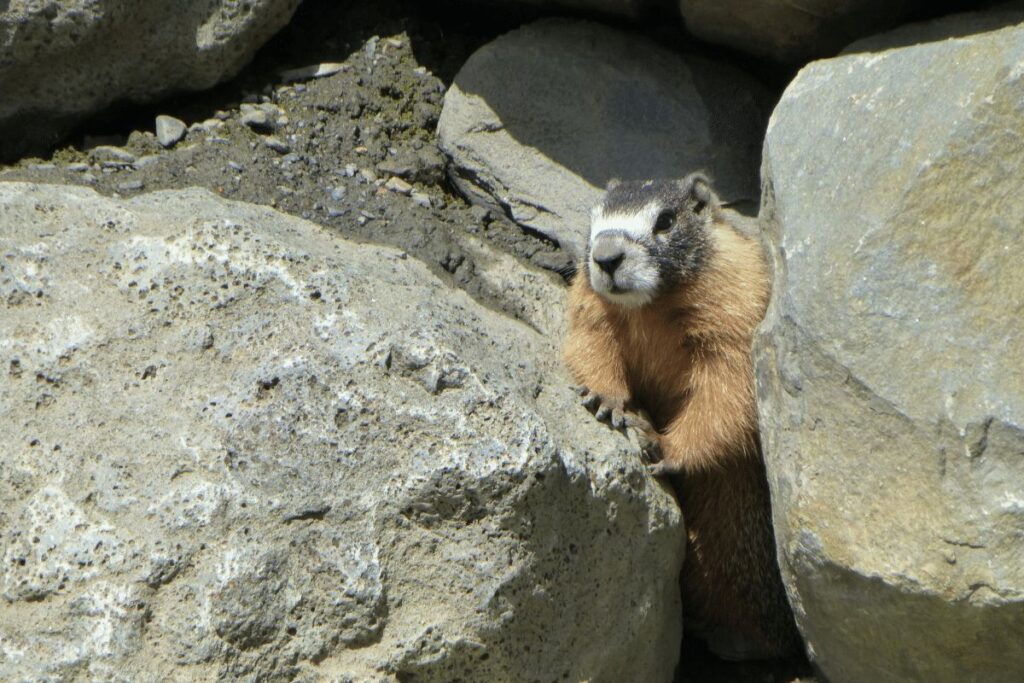
Hoary Marmots are found in alpine regions and subalpine meadows throughout western North America. In Jasper National Park, they are commonly found in areas such as Whistler’s Mountain and the Valley of the Five Lakes. These animals are herbivorous and primarily feed on grasses, sedges, and flowering plants. They are also known to hibernate for up to eight months of the year.
Hoary Marmots are important members of the alpine ecosystem as they are a source of food for predators such as golden eagles, grizzly bears, and wolves. They also play a role in seed dispersal as they transport seeds of plants they feed on throughout their habitat.
In Jasper National Park, the Hoary Marmot is protected by conservation efforts to preserve their natural habitat and prevent human disturbance. Visitors are encouraged to observe these animals from a distance and to never feed or approach them.
If you are interested in seeing Hoary Marmots during your visit to Jasper National Park, it is recommended to explore alpine meadows and subalpine regions. Keep an eye out for these playful creatures sunning themselves on rocks or foraging for food. Remember to respect their natural habitat and observe them from a safe distance.
Pika
During our trip to Jasper National Park, we were fortunate enough to catch a glimpse of the elusive pika, a small mammal that belongs to the lagomorph family, which includes rabbits and hares. These creatures are commonly referred to as “rock rabbits” due to their preference for rocky alpine terrain, where they can hide from predators and keep cool during hot summer months.
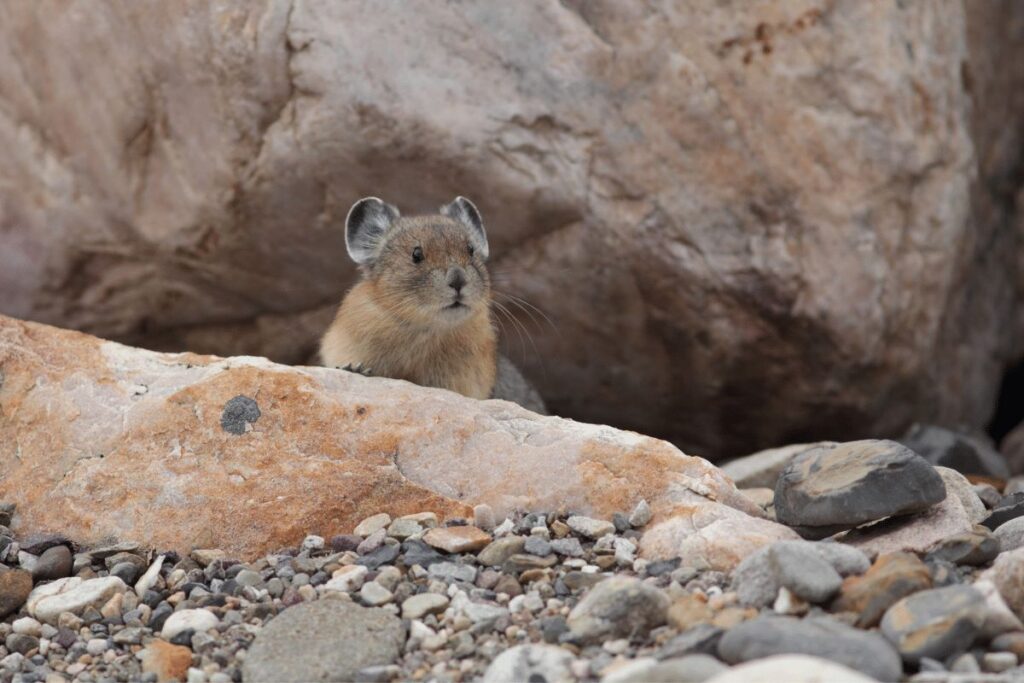
The pika is known for its distinctive call, which sounds like a high-pitched “eep,” and it is often described as being similar to the sound made by a smoke detector low on batteries. This call is used to communicate with other pikas and to warn them of potential danger.
Despite their small size, pikas are incredibly hardy animals that have adapted to survive in the harsh alpine environment of Jasper National Park. They are known for their remarkable ability to gather and store food for the long winter months, a process known as “haying.”
Pikas collect grasses, herbs, and other vegetation during the summer months and dry them out in the sun before storing them in “haypiles” beneath the rocks. These haypiles can weigh up to 60% of the pika’s body weight and provide them with the necessary sustenance to survive the long winter months when food is scarce.
Pikas are also an important indicator species for scientists studying the effects of climate change on alpine ecosystems. They are highly sensitive to changes in temperature and precipitation, and their presence or absence can provide valuable information about the health of an ecosystem.
If you are lucky enough to spot a pika during your visit to Jasper National Park, remember to keep a safe distance and observe them from afar. They are a precious part of the alpine ecosystem and should be treated with respect and admiration.
White-tailed deer
During our hiking trips in Jasper National Park, one of the most commonly sighted animals was white-tailed deer. These beautiful creatures are easily recognized by their white underside and tail, as well as their reddish-brown coat.
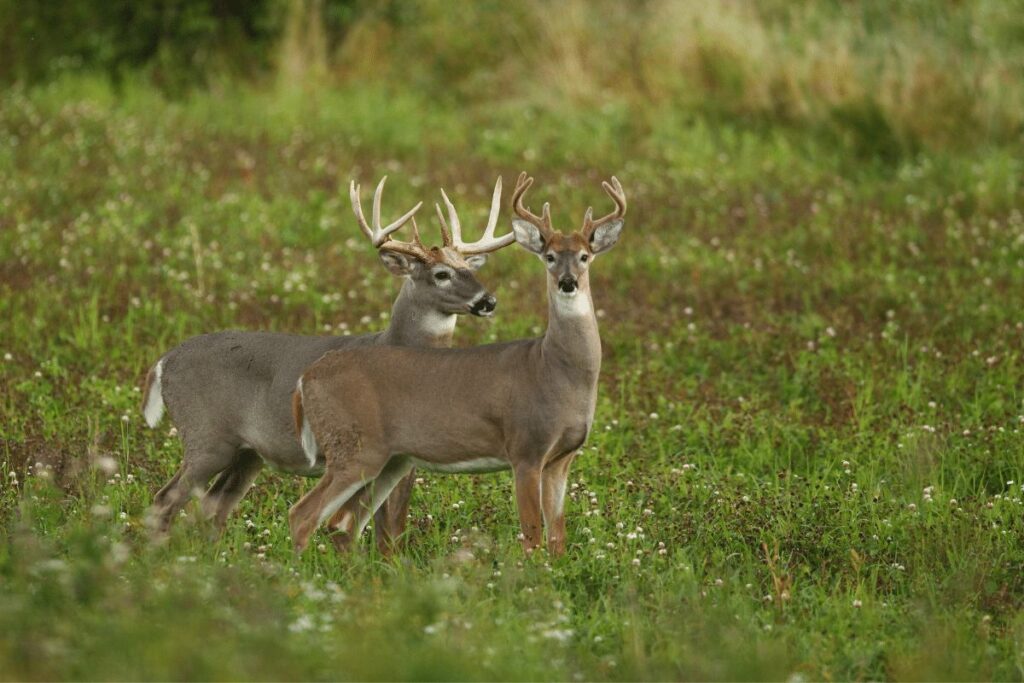
White-tailed deer are abundant in the park and can be seen on many hiking trails, including the Valley of the Five Lakes trail, the Old Fort Point trail, and the Maligne Canyon trail. They are primarily browsers and feed on leaves, twigs, and bark of deciduous trees, as well as grasses and sedges.
White-tailed deer are a key component of the park’s ecosystem and play an important role in supporting the predator population, such as wolves and cougars. They are also a vital food source for bears, both black and grizzly, who rely on them to fatten up for the winter months.
If you’re planning a trip to Jasper National Park, keep your eyes peeled for these graceful creatures on your hikes. Remember to give them their space and avoid approaching them too closely, as they are wild animals and can be unpredictable.
Great Horned Owls
During our nature exploration in Jasper National Park, we were lucky enough to spot several Great Horned Owls. These majestic birds are one of the largest owl species in North America and are easily recognizable by their prominent ear tufts and yellow eyes.
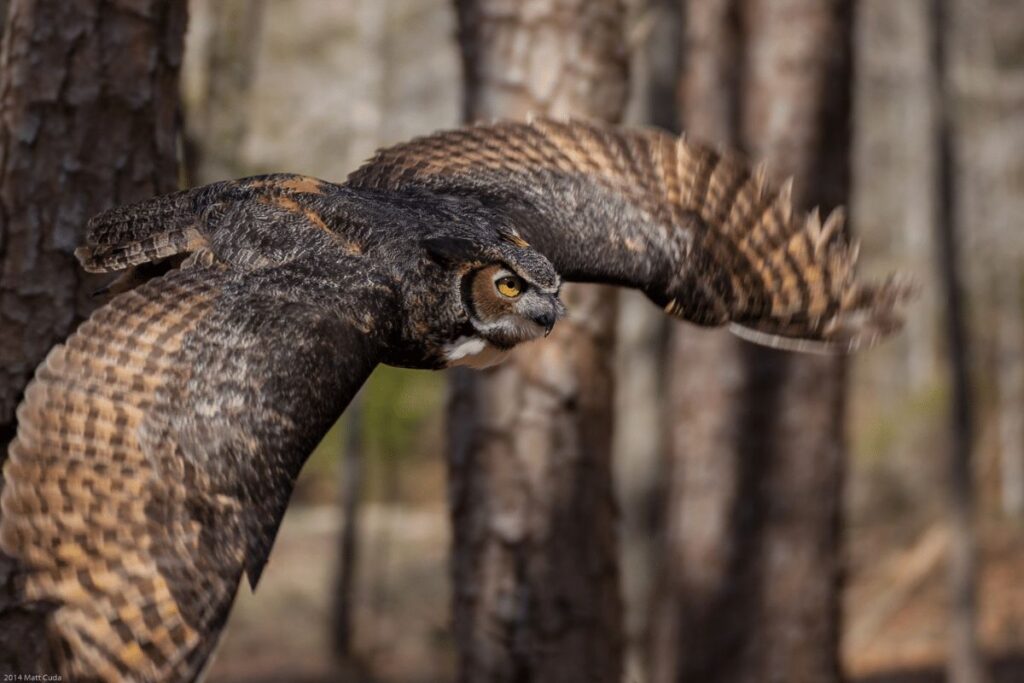
Great Horned Owls are well adapted to their habitat in Jasper and can be found in various ecosystems, including the forests and grasslands. They are primarily nocturnal hunters and feed on a variety of prey, including rodents, rabbits, and even other birds. Great Horned Owls play an essential role in the park’s ecosystem by regulating the populations of these animals.
Jasper National Park is home to a healthy population of Great Horned Owls, making it a great place to spot them. They can often be seen perched in trees or flying overhead during the early morning or late evening hours. Visitors can increase their chances of seeing these beautiful birds by joining guided wildlife tours or exploring the park’s trails.
As with all wildlife sightings, it’s important to remember to observe from a safe distance and not disturb the animals. Great Horned Owls are protected in Jasper National Park, and it’s essential to respect their habitat and behavior.
White-Tailed Ptarmigan
During our hiking trip in Jasper National Park, we were fortunate to have multiple sightings of the beautiful White-Tailed Ptarmigan. These birds are well adapted to the harsh alpine environment and are commonly seen on hikes throughout the park.
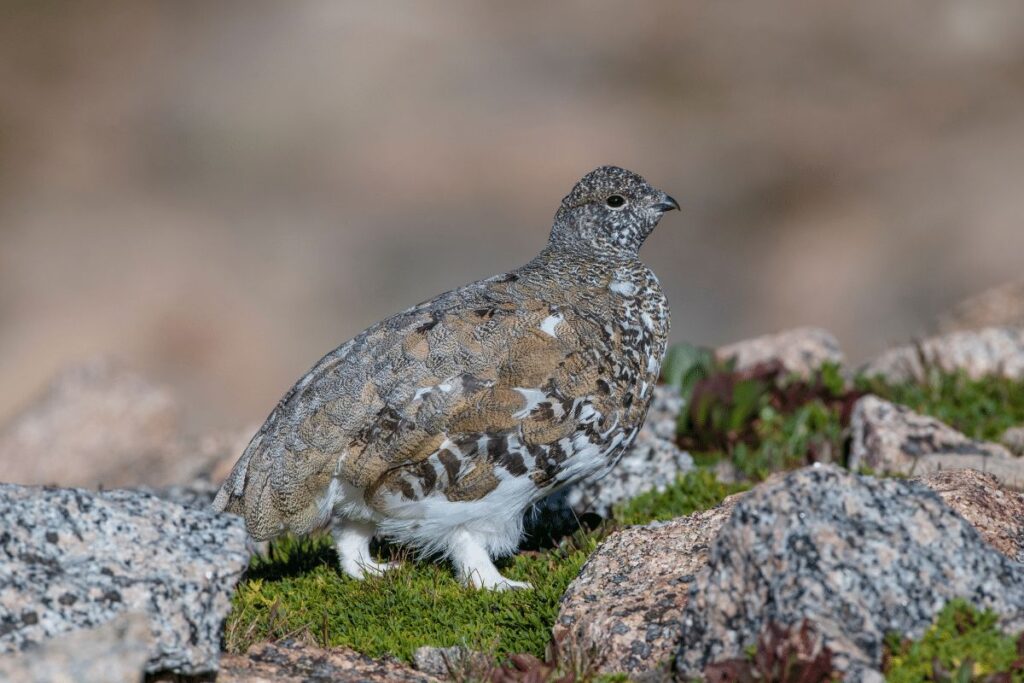
They are the smallest species of ptarmigan in North America and are easily identified by their white feathered tails and cryptic brown, gray, and white plumage.
The White-Tailed Ptarmigan is unique in that it spends its entire life at high elevations, even during the breeding season. In the spring, males begin to court females by calling and displaying.
Once paired, the female will lay a clutch of three to nine eggs in a shallow depression on the ground, often in a protected area beneath a rock. The eggs hatch in about three weeks, and the chicks are able to fly within ten days.
Ptarmigans play an important role in the alpine ecosystem as a food source for predators such as Golden Eagles, Great Horned Owls, and Coyotes. They are also important indicators of the health of alpine ecosystems. Due to their sensitivity to environmental changes, researchers study their populations to monitor the impacts of climate change on alpine environments.
If you are interested in seeing these beautiful birds during your visit to Jasper National Park, the best time to spot them is during the summer months when they are most active. They are commonly seen on hikes throughout the park, including the Skyline Trail and the Wilcox Pass Trail.
Bohemian Waxwing Sleek
During our hiking trip in Jasper National Park, we were thrilled to come across a flock of Bohemian Waxwings. These sleek, medium-sized birds with striking crested heads and bold markings are a sight to behold. With their distinctive rusty-red and yellow wingtips, they are easy to spot even from a distance.
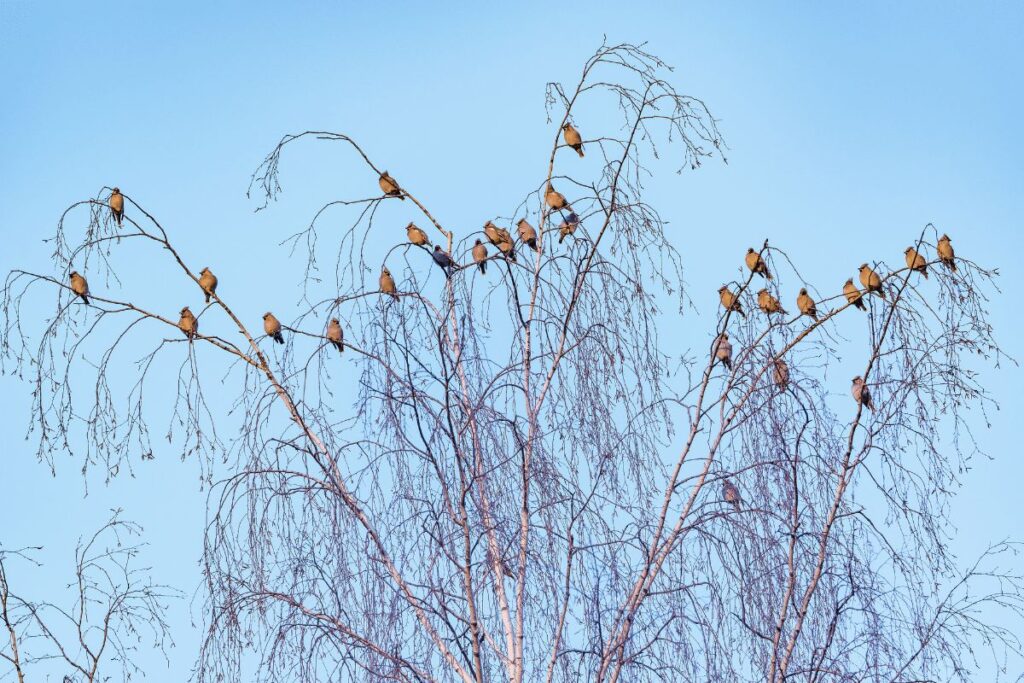
Bohemian Waxwings are not a rare sight in Jasper National Park, and they are often seen in flocks foraging on the ground for berries, particularly in the winter months. They are social birds and can be seen flying in large groups, producing a distinctive high-pitched whistle as they call to each other.
The sight of these beautiful birds was a memorable highlight of our hike. We watched in awe as they hopped from branch to branch, occasionally taking flight to catch an insect or a berry. It was fascinating to observe their behavior and marvel at their beauty up close.
If you’re planning a trip to Jasper National Park, keep an eye out for these stunning birds. They are often seen along trails or in the trees near berry bushes. Bohemian Waxwings play an important role in the ecosystem by dispersing seeds from the berries they eat and providing a food source for predators such as hawks and owls. Seeing these elegant birds in their natural habitat is truly an unforgettable experience.
A Visual Story: Wildlife We Saw in Jasper National Park: 13 Sightings!
Conclusion
The wildlife sightings we experienced in Jasper National Park were truly unforgettable. We saw some of the most majestic creatures on earth, as well as some smaller critters that are just as fascinating.
From the elk grazing peacefully in a meadow to the wolves hunting for food along a riverbank, our time spent exploring Jasper National Park was nothing short of spectacular. Whether you’re planning a trip there soon or simply looking for an escape from reality, this beautiful park offers something for everyone!

